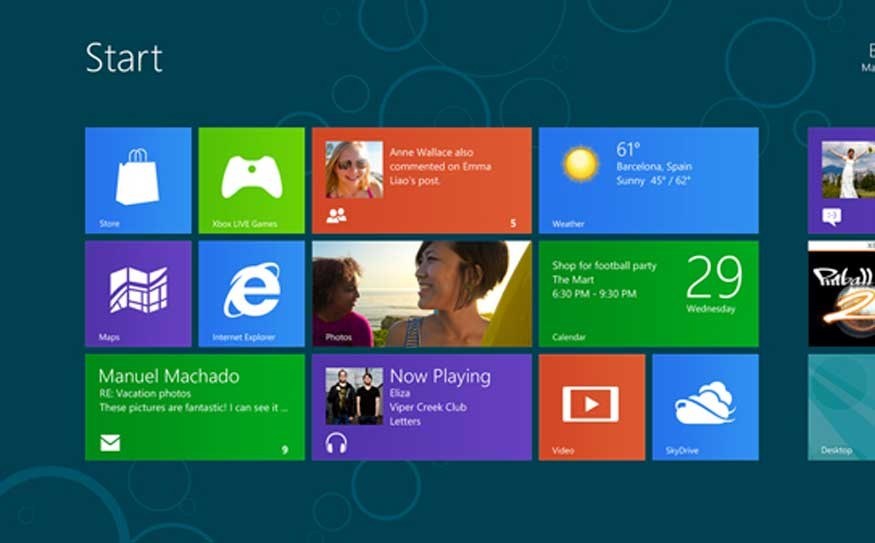Last week, Microsoft released the Consumer Preview version (a.k.a. Public Beta) of Windows 8, which of course followed the Developer Preview released back in September 2011. The official release should follow sometime this year — probably October, if rumours are correct.
This is a big event in the computing world, or the 90 per cent of computer users out there that haven't switched to Apple.
Windows 7 is great, a stable, intuitive and powerful operating system, but it was always missing that cross-platform feeling you get from Apple that translates between computers, phones, tablets and gadgets. Windows 8 will be a complete environment with versions for devices like phones and tablets, laptops and desktops, identical in look and feel.
I downloaded my test version of the Developer Preview immediately and overall, after about 10 hours playing with it, I have to say I'm impressed. This is not some incremental update to the look and feel of an operating system, this is the future. I really feel that Microsoft has leapfrogged the competition and redefined computers for the next generation.
The most controversial aspect of the new operating system is the "Metro" interface, which replaces the familiar Windows desktop with a stack of colourful squares and rectangles. Some of the tiles tell you the weather or what's happening on a particular news feed; others launch programs like your browser, the video game you've been playing, specialized apps, or folders with photos and videos. You can also click on a tile to back out to the familiar Windows desktop, minus the Start menu (although someone has already released an add-on that brings it back).
The tiles in the Metro section are grouped according to type or to your own preferences, and you can easily swap between collections of tiles with a sweep of the mouse. You can add anything to Metro with a right click, or take anything away that you don't want up front.
As cool as it was I found myself wishing that my laptop had a touch screen, sure that I was missing out on the full experience. Something is definitely lacking using my laptops' trackpad, and I found it annoying going to corners to open the dock (left corners) or "charms" bar (right corners) in order to get all the functions that used to be at the top or bottom of the screen.
I'm not really a traditionalist when it comes to how a desktop should look. I use Apple at work, Windows 7 at home and I've toyed with Linux in the past. I'm fine using iOS, Android, Window Phone 7, Xbox, etc.
All things considered I can honestly say Windows 8 is a huge departure from any of those working environments. It's different in every way and while that's bound to cause some headaches for people who dislike big changes it really doesn't take long to catch on.
The desktop is the desktop and you're going to be spending a lot of time there, but Metro takes some getting used to. There are no icons to size or reduce windows, and all Metro-optimized apps and programs (like the new Internet Explorer 10, which is surprising good) run full-screen or half screen with all of the menu items buried in the charms bar. Metro puts the things that you use most often, or are most important to you, front and centre, but it's really only the tip of a very big iceberg that takes some practice — and some knowledge of shortcuts — to get used to.
I expected that Metro would probably be heavy on memory usage to keep all those Metro tiles updated and scrolling so smoothly, but didn't notice anything dramatic when I looked at my system performance and it actually seemed to use less memory than Windows 7. That's because the Windows 8 is not just an update to the Windows operating system, but a system that has been re-engineered to work better. One of the fixes over previous operating systems is the fact that the system prevents non-essential programs and apps from running in the background, especially at Startup, and in that sense it's as close to a "clean" system as you're ever going to find.
That said, I'm not recommending that people download Windows 8 just yet. For one thing, the apps — probably the biggest feature of Metro — aren't available for Canada at this point, except for a handful of built-in apps for mail, weather, instant messaging and so on. Without apps the Metro experience is sorely lacking.
And without a fully functioning Metro, you're probably going to find the other changes annoying — like the lack of window controls, getting used to using the charms bar instead of menus, navigating between programs from the corners and all the time you'll spend setting up Metro to fit your needs.
Of course you're not expected to figure all this out on your own. An introduction to Windows 8 comes with the download and is worth a few minutes of your time. Articles with tips and tricks are already surfacing, as well as lists of all the new shortcuts that will make Windows 8 a breeze to navigate.




